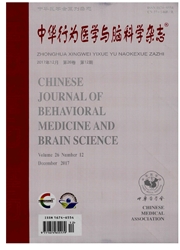

 中文摘要:
中文摘要:
目的 探讨甲基苯丙胺长期戒断者的决策特点.方法 以戒断时间在6个月以上的24名甲基苯丙胺(methamphetamine,MA)依赖者和24名健康人为被试,运用爱荷华赌博任务(Iowa gambling task,IGT)测试甲基苯丙胺依赖者的决策特点,并分析其与冲动性(BIS-11量表)和药物滥用史的相关性.结果 MA组和健康组在IGT净得分上差异无统计学意义[分别为(-10.75±24.32)分和(-5.96± 14.45)分].面对纯收益情况时,健康组和MA组的换牌率差异无统计学意义[(50.92±25.04)%和(48.67±24.92)%],而当面对净损失时,MA组的换牌率[(71.46±24.09)%]显著低于健康组[(87.96±20.34)%,F(1.46)=6.57,P=0.01].MA依赖者BIS的得分和净损失情境下的换牌率呈负相关(r=-0.43,P=0.04),和纯收益情境下的换牌率呈负相关(r=-0.47,P=0.02).结论 MA依赖者表现出决策功能上的缺陷,决策策略固着,风险耐受性高,对即时奖赏敏感,这种特点与冲动的人格特质有关.
 英文摘要:
英文摘要:
Objective To investigate the decision making deficit of former methamphetamine (MA) users following a long period of withdrawal.Methods Twenty-four MA dependent individuals who had been withdrawal for longer than six months and 24 healthy controls were recruited to undertake an Iowa gambling task (IGT) assessment in order to evaluate decision making function.Correlation analysis was done to investigate the relationship between IGT,impulsivity (Barratt Impulsivity Scale-11) and drug use characteristics.Results There was no difference in net IGT scores between MA group and controls((-10.75t24.32) vs (-5.96± 14.45)).Differential performances appeared when facing different benefit-loss conditions.When facing pure-gain cards,controls and MA abstainers changed their card in the same frequency((50.92±25.04)% vs (48.67±24.92)%),but when facing net losses,MA abstainers((71.46±24.09)%) changed their card less often than controls(87.96±20.34) %) (F(1.46=6.57,P=0.01).The BIS score negatively correlated with the card change ratio under the net-loss condition (r=-0.43,P=0.04) and the pure-gain condition (r=-0.47,P=0.02).Conclusion The study confirm the hypothesis that MA dependent individuals show some deficits in their decision making.These individuals seem to utilize a risky decision making pattern and tolerate high risk.The high tolerance to risk might be associated with impulsivity.
 同期刊论文项目
同期刊论文项目
 同项目期刊论文
同项目期刊论文
 期刊信息
期刊信息
